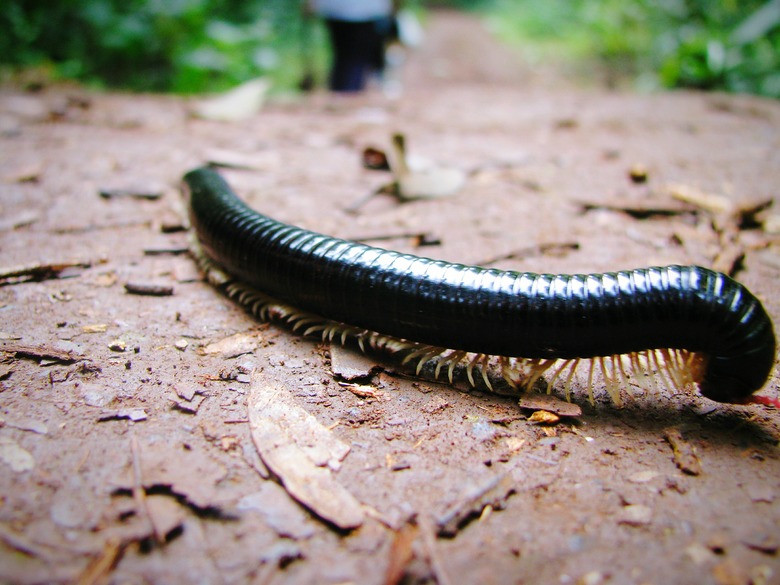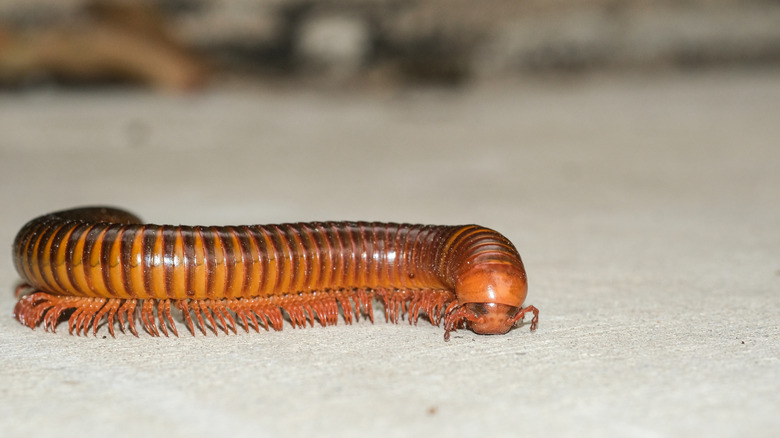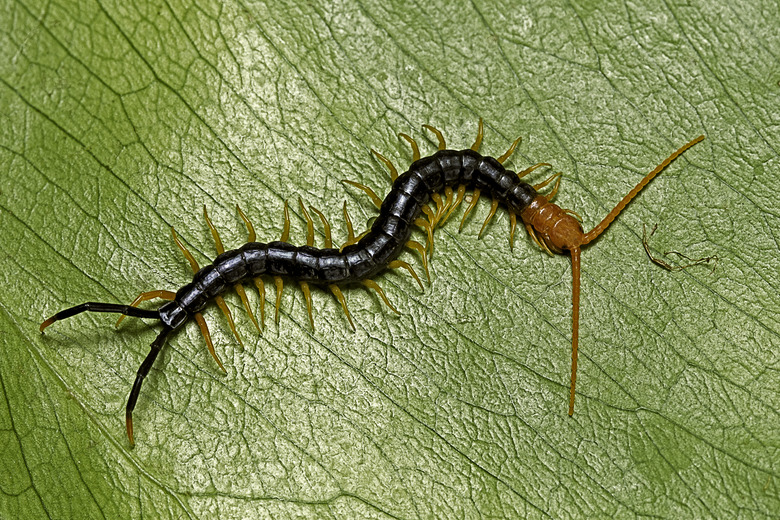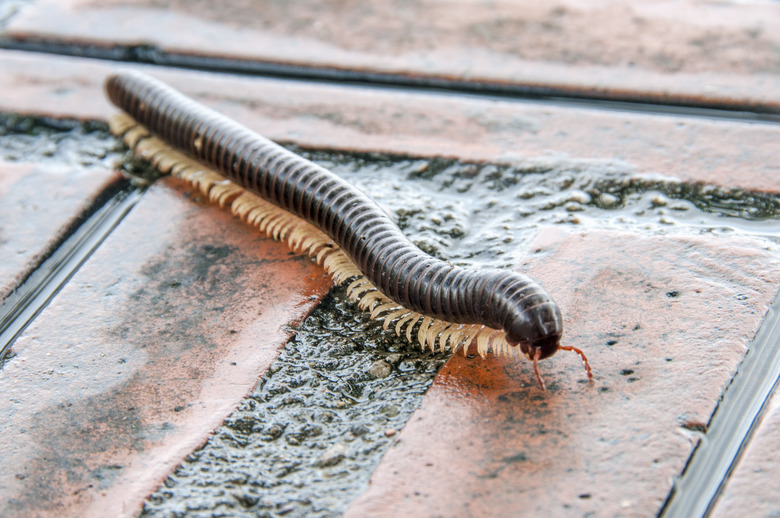How To Get Rid Of Millipedes
We may receive a commission on purchases made from links.
If you see millipedes in your home, you can take heart knowing they don't want to be there. Millipedes like to eat rotting plant material and prefer to live where it's moist and damp. As such, they would much rather live outside than share your home with you (thankfully).
Any millipedes you see most likely wandered into your house quite by accident and then failed to find the way back out. This is good news, as it makes a millipede infestation highly unlikely. Instead, you'll only need to deal with the occasional stray.
Often called thousand leggers, millipedes actually have between 80 and 400 legs on average. Each body segment contains two pairs of legs unlike centipedes, which possess only one pair of legs per body segment. Although frequently lumped in with insect pests, millipedes are not insects at all; they are arthropods. Arthropods are invertebrates with segmented bodies and jointed appendages. You're most likely to bump into these nocturnal creatures after sunset.
What Do Millipedes Look Like?
What Do Millipedes Look Like?
- Species name: Diplopoda spp.
- Physical characteristics: Typically 1 to 2 inches long, 80 to 400 legs, segmented body, will curl into a ball if disturbed
- Wings or wingless? Wingless
- Color/species varieties:
Brown, black, or reddish in color - Life cycle and appearance: Eggs hatch into legless larvae, and larvae then become adults who molt periodically as they grow.
- How to tell apart from lookalikes: Often mistaken for centipedes, millipedes move much more slowly and are darker in color. Centipedes have anntennae on both ends of their body.
How to Get Rid of Millipedes
How to Get Rid of Millipedes
Millipede control is generally not a difficult task, and there are several ways to go about it. All are easy and relatively inexpensive. Always remember to be careful, however, when using chemical controls around pets and kids. You can eliminate most millipede problems in just a few days.
Boric Acid
You can kill millipedes you see and discourage future millipede visitors by sprinkling some boric acid powder in your home. You can sprinkle the powder along your basement walls and other places you see millipedes. You can also use a duster to insert boric acid into cracks or holes. As the millipedes crawl across the boric aid, its rough surface cuts into them and dehydrates them. It also disrupts their digestive system.
When opting for boric acid, exercise caution. Never use boric acid where children or pets could find it. Children and cats are particularly sensitive. When spreading boric acid, take care not to inhale it.
If you have concerns about boric acid toxicity, use food-grade diatomaceous earth (DE) instead. Made from the pulverized fossils of ancient sea creatures, DE cuts and dehydrates millipedes just like boric acid. DE is nontoxic; however, you may still experience throat and lung irritation if you inhale it. DE works a bit more slowly than boric acid, but the delay is well worth it if it means keeping those in your household safer.
When to Hire a Pro
When to Hire a Pro
Ridding a house of millipedes is something most homeowners can do themselves. If, however, you're still seeing millipedes after cleaning up the things that attract them and sealing your home, you may want to call in a pro for backup. A professional exterminator may find a few cracks that you missed when sealing the home. The average cost for an exterminator visit is around $176.
When hiring an exterminator, find one with a good reputation and ask for references. You should also try to find a company that offers some type of guarantee or warranty on its work. Get a few estimates and verify that the company you choose will send a licensed pesticide contractor to your home. Ensure that the company is willing to give you information about any insecticides it uses or if it is willing to choose natural and environmentally friendly pest control options if that is your preference.
Getting Rid of Millipedes Naturally
Getting Rid of Millipedes Naturally
Pesticides are a fast and easy solution to millipede problems, but there are many natural ways to effectively deal with these pests. Whether you're worried about using pesticides in your home or simply want to be environmentally friendly, you have several natural options.
Wait Them Out
It's true that millipedes can live five to seven years, but that won't happen inside your home. As long as you've cleaned up any sources of food or water, any millipedes living in your home will die of starvation or dehydration in a few days.
Hand Pick Them
Because full-on millipede infestations aren't all that common, you'll probably only see one millipede at a time. If so, you can simply catch it in your hand and take it outside. They don't bite, but some do emit a foul-smelling chemical when disturbed, so wash your hands after handling them.
If the thought of touching a millipede leaves you utterly grossed out, suck them up in your vacuum cleaner instead. A trip through the vacuum may or may not kill the millipede. Change your vacuum cleaner bag and dispose of it right away in case the millipede is still alive in there. That way, you know it won't come crawling back out.
Make a Trap
Another option for millipede removal is to build a simple trap. To do so, put a piece of very ripe fruit in the bottom of a bottle. Place a piece of tubing snugly in the neck of the bottle, positioning it so that it extends about 2 inches in. Caulk or tape the tube in place.
Position the trap where you see millipedes. Place the bottle on its side so that the outside of the tube touches the floor. Make sure the inside part of the tubing doesn't touch the inside of the bottle. Millipedes will then crawl into the trap to go after the fruit and be unable to crawl back out. Once trapped, you can dispose of the bottle or release the millipedes back into the wild.
Essential Oil Spray
Rumor has it that millipedes dislike the smell of tea tree and peppermint oils. To use them, place a few drops of oil in a spray bottle of water and spray the mixture anywhere you would a chemical pesticide. Spray along baseboards as well as along windows and doors. You can also spray the oil outside along the foundation of your home and in the garden. Remember to reapply outdoor oils after it rains.
Essential oil sprays help to discourage millipedes from entering your house, but it won't kill them. If you wish, add a little dish soap to your essential oil mix, essentially making your own insecticidal soap. Insecticidal soap kills millipedes on contact, so you can use your handy squirt bottle to quickly kill any millipede you see. Combining the soap and essential oils allows your spray to do double duty, killing any millipedes you see while repelling ones you don't.
How Millipedes Get In Your House
How Millipedes Get In Your House
Millipedes don't even like living indoors, so how and why do they come inside? Usually, millipedes are found outside your home living in mulch or decaying plant matter, often in flower beds or near foundation plantings just outside your home. After a period of cool weather or a bout of heavy rain, the millipedes may start to look for a dryer or warmer place to call home. Their search may lead them to discover a crack or opening in your home quite by accident.
Although there isn't really a millipede season, you're most likely to stumble across a millipede in the spring or fall. At these times, changing weather conditions can cause mass migrations of millipedes looking for a more hospitable living environment. Although a few more than usual may find their way indoors at these times, take comfort in the fact that millipedes don't reproduce indoors. Once you're rid of the adults, your millipede issue should be fully resolved.
How to Prevent Millipedes
How to Prevent Millipedes
There is no point in evicting millipedes from your home if you're simply going to invite them right back in. To really eliminate them, make your home less hospitable to millipedes.
Clean Up
Dry out any standing water in your home and install a dehumidifier in damp basements and crawl spaces. Clean up any old and rotting debris, like that open bag of mulch in the garage or the pile of old newspapers in the basement. Make sure you also repair any leaky faucets or pipes, as these will thwart your efforts to keep your home dry and free of unwanted moisture.
Seal Your Home
Next, use caulk or expanding foam to seal any cracks or crevices in your home, particularly in the basement. Seal around your windows and other entry points and install new weatherstripping around your doors.
Make Your Outdoor Space Less Attractive
Go outside and see if your lawn needs any millipedeproofing. Move mulch, woodpiles, pine needles, and decaying plant matter away from your home's foundation. Rake up leaves in your lawn and garden and keep the landscaping tidy. Water your lawn and outdoor plants as sparingly as you can to avoid excess moisture. When cleaning up old mulch, fallen leaves, and other outdoor clutter, remember to clean your downspouts. Downspouts full of rotting plant material are perfect hangouts for millipedes.
Keep your grass mowed short so it dries more quickly after rain showers and dethatch it when the grass clippings start to build up and hold moisture. Millipedes overwinter in the soil, so provide as little cover for them as you can. Replace worn weatherstripping as well to help keep them outside.
Do Millipedes Cause Damage or Spread Disease?
Do Millipedes Cause Damage or Spread Disease?
Millipedes are a nuisance, but they're a harmless one. Although stumbling across one may startle you or make your skin crawl, millipedes won't hurt you. They don't bite, and most simply curl into a tight ball when disturbed. Some species, however, can emit a foul-smelling chemical that may irritate your skin. To avoid problems, simply wash your hands well after handling a millipede.
Millipedes eat rotting organic matter, so you need not worry about them nibbling on your clothing, damaging carpets, or boring into wooden structures like some other pests. Your lawn and garden are equally safe. Millipedes eat decaying plant matter rather than live plants, so anything on which they munch is already dead.
References
- Northwest Exterminating: When Is Millipede Season?
- Northwest Exterminating: Why Are There So Many Millipedes in My House?
- University of California Statewide Integrated Pest Management Program: Centipedes and Millipedes
- Ortho: How to Get Rid of Millipedes in Your House
- Northwest Extermiating: How To Get Rid of Millipedes Naturally
- HomeAdvisor: How Much Does an Exterminator Cost?
- National Pesticide Information Center: Boric Acid
- United States Environmental Protection Agency: Tips for Selecting a Pest Control Service




